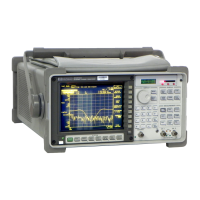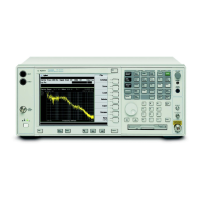Math Operations
and Data Editing
You can use the analyzer’s [
Analys
] menu to set up math operations and edit the
contents of the analyzer’s data registers.
Math Operations
Using constants and functions, you can perform a variety of operations on
current (or stored) traces. You can use math to modify the results of a
measurement—for example, to compensate for a fixed gain (or loss) in a
system-ordevice-under-test. Youcanalsouseamathoperationtomodifya
trace—for example, to invert a trace. And you can use math to add, subtract,
multiply, or divide two traces or operate on a trace with a constant or a
complex constant.
Special Considerations
It is not difficult to use math operations, but there are some things you should
know before building your own math functions:
• A math function can contain the current input data, a stored trace, or a constant.
• Math functions are specified by entering the definition with operands and operators
in standard algebraic notation.
• To exit any math menu without affecting any function of constant definitions,
simply press any hardkey.
• Math operations are stored in volatile RAM. They remain after a preset, but are lost
if you cycle power.
Editing Data Registers
Data editing allows you to change the trace stored in a data register. You can
define a line segment by specifying the start X and stop X positions, then
entering the start Y and stop Y values. The analyzer connects the two points
with a straight line. You can insert as many lines as you need.
You must modify start Y or stop Y. If you do not change either Y-value, the
analyzer does not change the data between the two points. You can then move
startXandstopXtodefineanewband.
Agilent 35670A
Math Operations and Data Editing Operator's Guide
18-2

